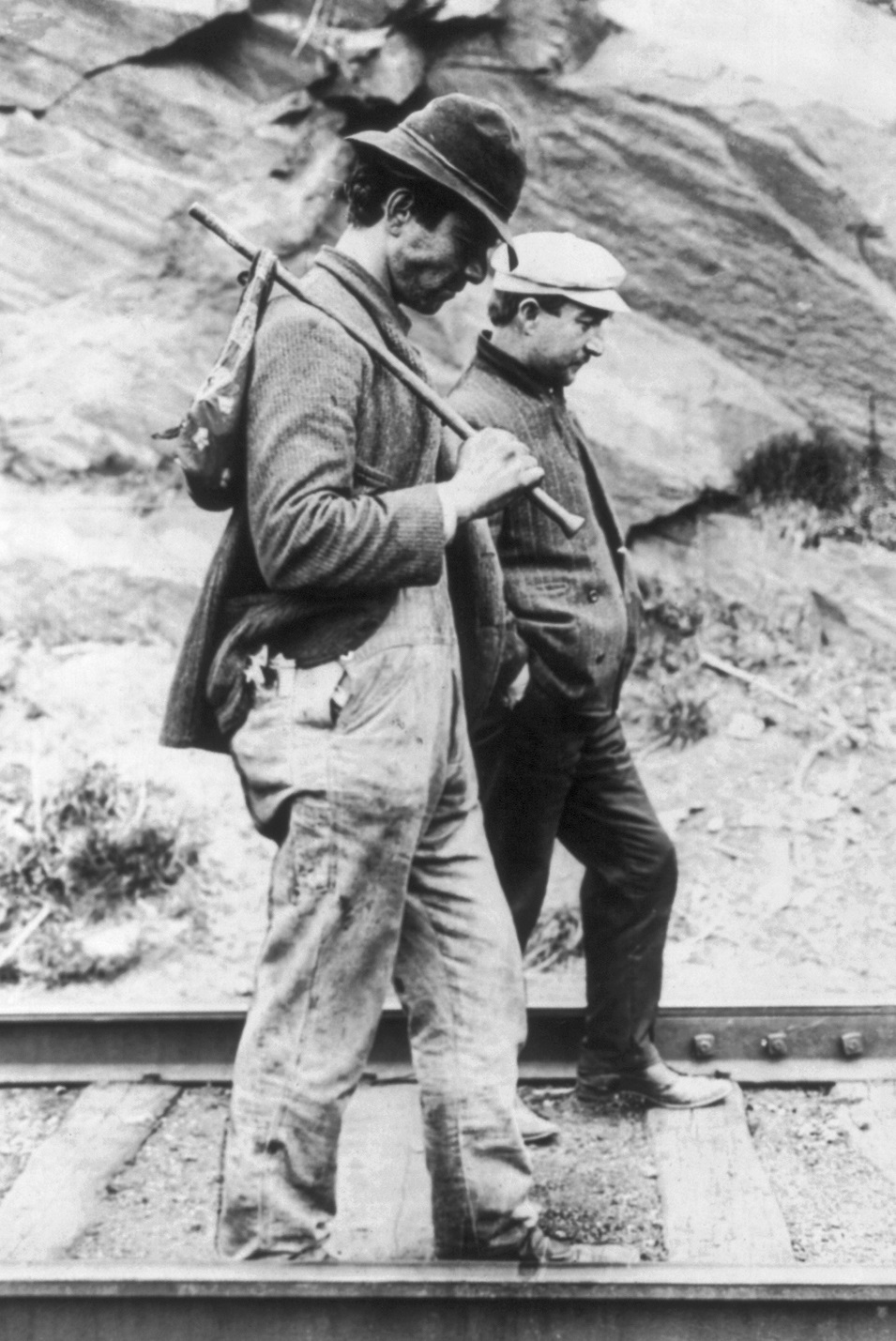Tramps have been around for centuries, but the last great economic upheaval that created the twentieth century’s reluctant nomads were the depression years of the nineteen twenties and thirties, where British unemployment reached 3.5 million, and poverty flung thousands onto the lonely and inhospitable roads in search of work. If, as was usually the case, they didn’t have the fares to travel from blighted regions like the South Wales valleys to wherever opportunity beckoned, well, they just walked instead. And walked; and walked; often for months on end, from one short-term job to another.
But where most saw their tramping days as a temporary expedient to be endured until a lasting job was found, and roots could be put down in a new place, a significant minority, curiously, fell into this way of life permanently.
George Gibbs lived in Lampeter in west Wales for 20 years but before that had spent more than three decades tramping the highways and byways of Wales, with only an old pram and a radio for company.
Originally from Glasgow, the son of a sailor missing at sea during World War I, Mr Gibbs joined the Merchant Navy in 1931, but leaving the sea in 1946, having had what amounted to a nervous breakdown, ‘..always thinking of the other ships that went up, the bombings and such like.’
He arrived home from leave in 1942 to discover his wife Flora had died after a bomb had hit their home in Clydebank.
After demobilisation in 1946 Mr Gibbs moved to Flintshire but – after giving up a number of jobs- he took to the road in the early 1950s. He was to spend the next 30 years tramping up and down Wales. He walked an estimated 90,000 miles in 30 years, with all his possessions in a pram. He spent many years working on farms in exchange for a night’s sleep in a barn and some food before moving on.
In 1970, journalist Byron Rogers met George and wrote about him and his  lifestyle for the Sunday Telegraph, and included his account in An Audience with an Elephant and other encounters on the eccentric side (2001). The following selection is by no means unbiased, these passages rather, demonstrate the same romance and freedom Laurie Lee captured so well in his autobiographical ‘As I walked out one midsummer morning’
lifestyle for the Sunday Telegraph, and included his account in An Audience with an Elephant and other encounters on the eccentric side (2001). The following selection is by no means unbiased, these passages rather, demonstrate the same romance and freedom Laurie Lee captured so well in his autobiographical ‘As I walked out one midsummer morning’
“ George Gibbs is one of that shrinking body of men steadily eroded by the processes of government who can ‘disappear’, for nine months of every year, in 20th-century Britain, he is beyond the reach of postmen and telephone calls. Gibbs comes at the end of a very long tradition, he is the last of the wanderers…
“For as long as there have been hearth fires and home acres some men have been forsaking them, to wander. Outraged legislation indexed their progress, spitting against ‘vagabondes, roges, masterless men and idle persons’ and ‘myghty vagabonds and beggars’..
“Society hounded and reviled its tramps because in their way they represented, like Soviet emigrants, an adverse comment upon it. Yet tramps acquired a haze of romance, particularly with growing urbanisation. They were the men outside, the bronzed wanderers, men with no axes to grind (though ironically this is how many earned their livings), with no families, no pasts, no future. The romance was, or course, in contradiction of the facts.. very few of them now did wander: those that remained were derelicts or alcoholics shuffling through city centres…
“Finally I found George. Mr Gibbs spent his winters at a Reception Centre near Bridgend, leaving each year with the spring, and by summer could be anywhere between Glamorgan and Anglesey, the difficulties in contacting a tramp are legion. I rang some of his regular stops without luck…
“There was one thing which characterised Gibbs: his fondness for the police force. Whenever he came to a town he would call at the police station to let officers know that he was in the area. Like an unofficial Inspector of Constabulary, he dropped in on their stations, chatted to them, discussed their families, promotions, moves, smoked their cigarettes and drank their tea. The Dyfed-Powys force offered to pass the message ‘up the line’ as they put it, to say I was interested in meeting George. A week later I was rung up from Machynlleth:
‘Mr Gibbs.’ said a voice, ‘is just entering town.’ Which made him sound like a gunfighter…
“It is 9.30 a.m. in Machynlleth. A smell of fresh bread drifts through the town.. George Gibbs is waking up. He has spent the night in an open shed which contains agricultural machinery, where across the entrance he has placed a series of planks and oil cans to detect intruders, so it is difficult at first to make him out in the gloom. Then there is a slight movement among a heap of old coats and sacking in the corner of the shed, and two large white eyes, like a lemur’s, peer out. Somewhere in the huddle a radio is switched on and pop music flares in the darkness. Mr Gibbs is awake…
“All night he has slept on some planking, covered by his coats, his feet in an old dog-food sack. He has slept well, as he always does. ‘I can’t sleep in a bedroom any more. I roll around all night. But when I sleep on a hard surface I sleep all night.’ Gibbs has slept well in abandoned boats, in telephone boxes with his knees pulled up like a Mexican, even, he confesses shamefacedly, in public lavatories. But mostly he sleeps in far more comfortable surroundings, in empty houses, or on dried bracken in snug barns…
Gibbs is a curious, shuffling, knock-kneed little figure. He weighs very little, like most tramps, just 8 stone.. He is bespectacled and bearded, and quite spectacularly grimy, a small boy’s dream figure of personal hygiene. He talks occasionally of romantic little morning dips in the River Conway but cannot quite remember when he last had one. ‘I prefer showers meself. It’s clean water. In a bath you’re lying in dirty water,‘ says George with the cold objectivity of a man who has not been in either for a very long time..
“George is not very forthcoming as to the point when his itinerant labouring tipped over into tramping, but it seems to have been a quite gradual process. At first he worked regularly: now the last time he remembers working was over six years ago, for five weeks in a Flintshire brickworks. ‘Quite interesting work,’ he says airily. On tramping itself he says, ‘Once you get on to the road it gets into the system. It’s like smoking: you get a craving. I just can’t get off.’
At Machynlleth he has just lit his fire and is perched in front of it like a small Fisher King, dangling his billy can in the flames at the end of a stick. George puts his tea in the bottom of the can and allows the water to boil up through it so one can almost eat the resulting mixture with a knife and fork, As he sits he talks in a soft, unflurried monotone. He says ‘Oh dear‘ a lot of the time; as an exclamation it covers the gamut of his feelings, which seem to run from mild surprise to mild upset..
“From Machynlleth, George was turning south. In the three months since he had been on the road he had moved north in a slow arc towards Anglesey, and was now going south along the coast. He travels eight miles on a good day, but intersperses these with rest days at intervals. ‘It’s not an easy life. I wouldn’t advise anyone to take to the road. It was really tough when I used to roam in the winter, maybe two to three inches of snow. I have difficulty getting my old pram through snow.’
“He is fortunate in having good health. Apart from pneumonia in the early 1950s he has been ill only once, when he went down with flu at Christmas time, 1969, having been soaked in a downpour on the way to Bridgend. The flu resulted in a spot on his lungs and he had to spend a month in hospital. He says of himself: ‘I’ve never been ill actually on the roads. Getting the air, day by day, and walking … quite healthy me.’ Yet he has little energy and tires easily. His teeth are bad. In his pram he has a jar of home-made jam which he has not opened in two years. ‘Can’t. It would play holy mackerel with my teeth, that.’
“There is an even tenor to his life, which all untoward events disturb, to send great ripples across it. Thus I came across the news of my coming on different pages of his books. Yet he accepted me the way he accepts everything and was soon introducing me to policemen. ‘This is Mr Rogers. He is writing the history of my life.’ They looked incredulously at his Boswell as we shuffled by.
George plans his trips in a very loose way. He has a vague overall target, like Anglesey, but changes his route as it pleases him. ‘A man like myself going on steadily, not bothering anyone bound for anywhere. Anywhere does me. A man who goes everywhere bound for anywhere..’
“This is the week up to his stay in Machynlleth.
Tuesday night: A chicken shed, between Barmouth and Dolgellau. George has slept here before. The farmer, who has been here 20 years, says that, of all the tramps who once called, George is now the last. ‘We would think now that there was something missing from the year if he didn’t call.’ George sleeps just outside the chicken wire. Piled neatly are some old paperbacks he left the year before, and which the farmer has let lie. Before he sleeps, George, who is unable to light a fire here, asks the farmer for some hot water for his tea. The chickens grieve and scuttle. ‘Nice listening to the chickens,‘ says George, ‘nicer than traffic.‘
…..Wednesday: Towards Dolgellau. First stop Barmouth rubbish tip, where George spends an intent half hour, disturbing the seagulls and finding only some week-old newspapers. He collects the week-old papers. As night comes on he settles down for the night in an open barn some 2 miles from Dolgellau: he has walked some 7 miles. He lights a fire, drinks yet more tea.
…..Thursday: Towards Dolgellau. First stop Dr Williams’ School, a girls’ boarding school on the outskirts of Dolgellau. He always stops here. This time he knocks on the kitchen door and is given some roast beef sandwiches and tea. It is his first meal of the day. George reaches Dolgellau about midday and claims his Social Security benefit. This is the first breath of economics in his world. A tramp can claim a day’s requirement, the amount of which is left to the local office, but which in George’s case varies from 40p to 60p. At Dolgellau it is 60p. It is, in some ways, a cruel sum: just the minimum to keep a man alive. Yet to George it is a bonanza. Though he is entitled to the rate daily, the nature of his wanderings means that he rarely claims it more than twice a week. He encounters little difficulty at the Social Security offices as he is by now well-known to the officers. They fill in his name and age and seek to establish when he last claimed. Cases have occurred where the quick and the very quick among tramps have succeeded in getting to more than one office in a day, leaving a trail of benefit claims. With his 60p he buys milk, ten cigarettes, a packet of tea, and two pork pies. He begins the slow winding climb out of Dolgellau. The night is coming on as he wheels his pram over the pass towards Abergynolwyn, a slow little figure lost in an eternity of cloud and rock. He plays his radio. That night he sleeps in a barn under Cader Idris. It is his most romantic place, a foot deep in dried bracken. He lights his paraffin lamp, makes tea with hot water from a nearby guest house, and eats his two pork pies. And so to bed.
Friday: To Abergynolwyn. He rises at 10.00 a.m., his usual time, drinks some more tea, again with hot water from the guesthouse, and starts. It is a glorious day. He wheels his pram along the perimeter of Tal-y-llyn lake to the village, where he buys a tin of rice and calls on the policeman. He and PC Edwards talk about the old, dead tramps. ‘They’re a dying race,’ says the policeman. His wife gives George some sandwiches and a pair of good old shoes. The shoes disappear into the pram. Everyone seems to be glad to see George. ‘Oh, it’s you,‘ says one old man. ‘Now I know summer is really here. You’re the first swallow.‘ George goes off the roads early, about 4.00 in the afternoon, as he is tired. Because of traffic, he is careful not to walk at night. He sleeps in an isolated little shed some miles from the village. As the dark comes in across the mountains, he lights a small fire, heats his rice and eats his sandwiches. He plays his radio into the small hours.
Saturday: To Towyn and beyond. On the way he passes one of his old sleeping places, or rather what remains of it. The place, an old cottage, has been demolished by the local council to make a lay-by. George mourns briefly for it: ‘There was an old mattress there. I used to sweep the floor with my little brush.’ At Ysguboriau Farm nearby, Mrs Gwenda Jones greets George: ‘This was one of the old tramps’ calls. We gave them bread and butter and tea. But they’ve all gone. This one must be the last of them.’ We plod thoughtfully on, through Towyn, to a railway crossing house. But the night has come and is full of cars. George decides to stop at a rubbish tip a mile from the house. Using the pram he drapes his ground-sheet into a lean-to tent, lights a fire and fries some old bacon, ‘what you would call a rough lay-down‘. The night is warm.
Sunday: A rest day. George ambles the last mile to the crossing house. It is being modernised but the doors are still open. George does not like the modernisation. ‘Oh dear, all this was wood once, wooden floors, wooden walls here. They’ve ruined it. I was quite warm. They’ve ruined it completely.’ He eats little today, some old bread and lard he has, and brews up. He plays his radio endlessly, pop, political reports and drama wafting into the bowed little head.
Monday: Towards Machynlleth. He walks 6 miles, calling at two houses for some hot water where he is given some bread and couple of raw onions. He stops the night at a cluster of modernised little cottages standing in a courtyard, all for some reason deserted. He makes a fire in the fireplace, fries his bread, and eats it with raw onions. So far in the week he has only once asked permission of a farmer to stay the night: nobody minds, says George, as long as he leaves the place tidy. Each morning he cleans up rubbish.
Tuesday: The last four miles to Machynlleth. He arrives early the afternoon, having called in the morning on the Rector, who gives him bread and butter, a cake and some tea, and tells me that he too, doesn’t know what’s become of the tramps. At Machynlleth George goes to the Social Security office, and is given 40p.’’
“‘The old-timers are all dead now, either found dead on the roadside or in derelict buildings. I’m not worried about whether I’ll be found dead. Everyone has to die, wherever he is, at sea, in a car, in a field, on a quayside. My ambition is to die in Wales, and be buried here.‘
Like a swallow, he begins to move South. The holiday cars flooding into Machynlleth shy away from the intent little figure on the road, like horses shying from some creature which has somehow sidestepped the past for the present. He disappears into Wales…
“ Latterly he had taken to spending his winters in a hut at Lampeter Station, so the district council, seeking to raze the station, was obliged to offer him a home under the 1977 Homelessness Act. He was by then of pensionable age, and the council’s action had made homeless a man for whom homelessness was a way of life. It has to be the most wonderful of all bureaucratic ironies. Mr Gibbs exchanged his old pram for a new bungalow in Lampeter.”













.jpg)